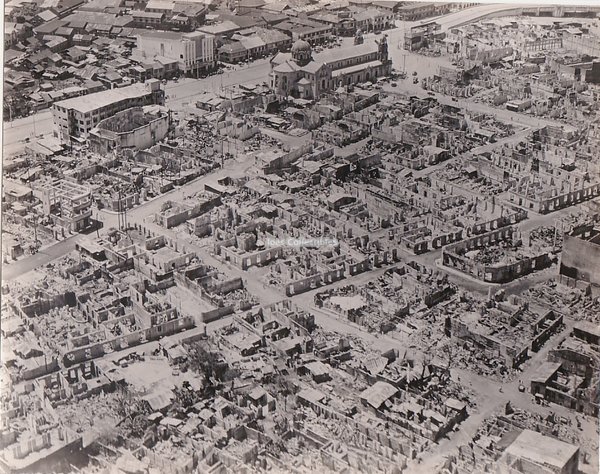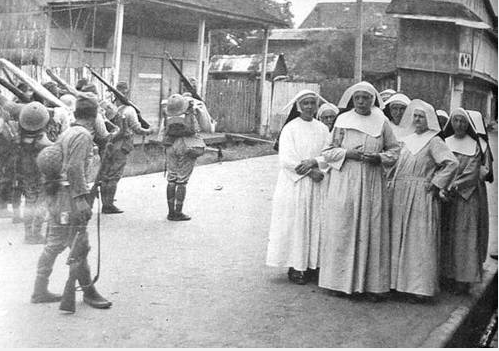Liberation That Destroyed: The End of Manila, Queen of the Pacific
By HECHO AYER: https://hechoayer.wordpress.com/2010/07/29/liberation-that-destroyed-the-end-of-manila-queen-of-the-pacific/
An Insult to Religious Filipinos’ Sensibilities: Nuns Being Rounded Up by Japanese Soldiers (http://img51.imageshack.us/i/image005wn.jpg/)
With no applause, but with artillery fire, American bombs, Japanese lust and death, Manila, Queen of the Pacific, made her inglorious bow to the world in February 1945.
Iconic Photo of an American Tank Forcing Its Entry Into For Santiago, Once Impenetrable (AHC)
In a single month, what was built for centuries to being Asia’s first and genuine melting pot was destroyed and forever erased from the world. The capital city of the Philippines became the stage for not only bodily massacre but also, spiritual, cultural, artistic and national eradication.
It was in 9 January 1945 when Lt. Gen. Walter Krueger arrived in Lingayen Gulf, Pangasinan in what would become a United States campaign to recapture the Philippines from Japanese claws. By the end of January, much progress has been made by the Americans in reaching the outskirts of Manila namely that of Tagaytay and Nasugbu. They began to make their way up north to Manila.
American Tank Inspects Intramuros’ Ruins. Notice the Walls of Sto. Domingo (AHC)
Backside of Once Marvelous Sto. Domingo Church (AHC)
The Manila Post Office (Where my Great Grandfather was Post Master General Before the War) (AHC)
On the other hand, the Commander-in-Chief of the Japanese mission to the Philippines, General Yamashita, has moved his headquarters to Baguio. He gave specific orders to make Manila an “Open City” and to simply destroy bridges and other critical infrastructures that may aid the Americans. He had no intention, whatsoever, of keeping Manila.
However, Rear Admiral Iwabuchi Sanji disobeyed the orders of his superior and launched a bloody and diabolical campaign to “defend” Manila to the end. With his motley group of Japanese soldiers, a month of suffering and sheer darkness engulfed the city of Manila, victimizing its citizens, its art, its culture, its heritage, its very soul.
The Intact Facade of San Francisco Could Have Still Been Restored (AHC)
When the Americans were making much advances into the city, the Japanese blew up Manila’s very historic and beautiful bridges, thus virtually dividing Manila into two: the Northern and Southern banks. In the eastern suburbs outside Manila, like Cubao, Kamuning and San Juan, the resistance against the Americans was minimal. My own lola and her two sisters and their mama moved to Cubao during this time precisely because they had a bad feeling of what would happen to Manila during those tense days. All girls, they were luckily spared. They were said to have only witnessed one violent act: the neighbor peeked while the Japanese were making the rounds when suddenly, he was shot in the head by a Jap who saw him.
Survivors of Intramuros Try to Escape The Place By Crossing the Pasig (AHC)
The National Assembly (AHC)
Likewise, although not without giving a good fight, the Japanese were unable to hold on to the northern banks of the Pasig. The areas here were the districts of Binondo, Sta. Cruz, Quiapo, etc.
In 3 February 1945, the US infantry, led by Atenean Manuel Colayco, managed to reach the Allied Internment camp that was actually the University of Santo Tomas’ sprawling campus. Its main building became the prison for around five thousand foreigners and Filipinos. The interment camp was captured the following day.
UST Concentration Camp’s Liberation (http://en.wikipedia.org/wiki/File:Santo_Tomas_Internment_Camp_Liberation_.jpg)
The situation, however, at the southern banks of the Pasig was far different. What is considered Manila’s most heavily concentrated area of rich architectural masterpieces, from ancient Spanish intramuros, to the American’s Neo-Classical corridor, as well as genteel Ermita, this area of Manila became the hiding place of the losing Japanese soldiers who became insanely cruel, killing people with no mercy.
The Navy Club on Fire, While Letran Being Heavily Attacked by the Americans Since There Were Japanese Hiding Inside (AHC)
According to the eminent Dr. Fernando N. Zialcita, my own professor in cultural heritage studies, the remaining soldiers in Manila, a good 10,000 marines, proceeded what would become infamously known as the “Manila Massacre”. Every morning, the soldiers would get heavily drunk before the roamed the city to kill civilians found in the streets. They began to set beautiful Filipino homes on fire (Ermita, Singalong and Malate became the worst hit residential areas), raid schools, kill orphans and even the mentally challenged.
Legislative Building Ruins (AHC)
Refuge in a Church (from LIFE Magazine)
Suddenly, Manila was in a bloodbath. As the Americans were pulverizing the Japanese daily with heavy artillery, tanks as well as a good 100 bombs dropped on the city per day, the Japanese violated women, raping Filipina ladies, preferring the young and mestiza-looking ones. They stabbed pregnant women, raped the foreign nuns and began bayoneting babies. Many accounts say how infants were thrown in the air only to be stabbed and impaled by Japanese soldiers’ swords. Men were immediately shot. Monks, priests, brothers and seminarians, in their cassocks and robes were grouped together, thrown a grenade at or shot. Irish and Spanish De La Salle brothers held in De La Salle Taft’s college chapel, with about two clans seeking refuge there, were coldly murdered by a marauding group of Japanese in an evening raid.
The Ruined Metropolitan Theater (AHC)
Orphanages, hospitals and mental asylums run by nuns were pillaged and menaced, wards murdered, nuns and nurses raped. The Neo-Classical buildings were burned by the Japanese and bombed by the Americans.
The Manila Hotel Ruins (AHC)
The Depressing Entry into the Post Office
But what was considered the scene of the worst fighting, and also the considered worst casualty was the Old Dame herself, the Intramuros. Her centuries-old walls did not last the heavy bombardment of American bombs, flame-throwers, bazookas, and grenades. Her citizens were hostaged by the Japanese in San Agustin. Priests keeping refuge in their monasteries were brutally killed. Because the Japanese, like rats, hid inside the old walls of Intramuros and inside the huge monastery complexes of Intramuros, the Americans felt it was their duty to bomb the entire place to rid Manila of the Japanese. And so, they dropped more than 100 bombs a day in that small area of Intramuros. After the war, the only structure left standing is also the oldest stone structure in the country, the mighty San Agustin, fortunately preserved from the destruction.
A Mass is Said Outside the Only Standing Church Left in Intramuros, the San Agustin (AHC)
What Could Have Been a Strong Reminder to Filipinos, the Facade of the Old Sto. Domingo was Torn Down by the Americans After the War
Intramuros – bastion of the Catholic Faith, repository of countless and priceless works of art, with documents and other materials that dated back since the very foundation of Manila, were burned and/or destroyed. It was caught in a cross-fire, its churches totally bombed-out, its palaces and mansions vandalized.
Slaughtered Bodies Found in Fort Santiago Dungeon Cell as Discovered by the Americans (AHC)
The Manila of our grandparents and ancestors’ affections was no more. After the war, it was said that more than 100,000 civilians, men, women, priests, nuns, babies, infants, mentally challenged, street urchins, were violently and mercilessly killed and violated. After the bombings, when all was left in dust, when the city was literally up in smoke, the Americans decided to BULLDOZE whatever was left in the city.
What Used to be the Magnificent Manila Cathedral (AHC)
What could’ve been restored, the facades of old churches, their old walls as well as the magnificent arches that used to be the doorways of mansions and palaces, were coldly bulldozed by the Americans. They wanted to make the entire city as fine as powder. Even the remaining facade of the Manila Cathedral was originally planned to be bulldozed. It was good though that the rich Don Santiago Picornell pleaded with American soldiers not to do such a horrid desecration.
Post-War Intramuros: With Only San Agustin Left, One Could Simply Trace the Outlines of the Corridors and Cloisters of the Numerous Convents
Yes, the chance of restoring and utilizing the ruins of Intramuros a la San Paolo’s facade in Macau, was lost. The Philippines’ gracious Manila streets, houses and government buildings were lost forever.
But what Manila lost was not simply its buildings; to an extent, it lost its very soul. With the extermination of Old Manila, came too the extermination of genuine Manila culture and heritage: the eventual loss of Spanish daily use in Manila, the strict sense ofurbanidad or civilized etiquette, the sense of art, the sense of pride, and the sense of grace that used to be lived by Manila’s residents, rich or poor, were all bashed and cruelly snatched. Manileños were seemingly shaken from their deep slumber – they now lived in a destroyed city, a city where every man was for himself, where finders were keepers. Its former museums, galleries, institutes for research, which all had a wealth of information and expansive collections were all destroyed thus severing generations of Filipinos from their glorious past.
Suddenly, Manila became rude, uncultured, hustling and bustling, forgetting the afternoon paseo, forgetting manners and conduct. Suddenly, Manila forgot its genteel and dignified past, its art, its stature and heritage. Suddenly, Manila’s residents rid themselves of the bitter memories of Manila, moving away from it and settling in Cubao, New Manila, Quezon Avenue, Makati, Pasay, and San Juan. The provincianos started coming into Manila, scavenging through the waste and setting up various squatter areas. Intramuros, being totally devastated, but also strategically close to the pier, became a huge squatters’ colony, with the poor occupying what used to be former mansions, hospitals and universities. Tondo, where the first kingdom of Manila was believed to have been found, became infamously crowded and turned into a slum.
 The Manila our grandparents knew will never be the Manila we will know.
The Manila our grandparents knew will never be the Manila we will know.
Though there are efforts, one thing we as a people should never forget would be the immense suffering and abuse our beloved capital endured in the hands of not the Spaniards (as we often blame everything to their regime!) but actually, in the hands of Americans and Japanese.
Quiapo District: Only the Quiapo Church is Left Standing (American Historical Collection – AHC)
We must never forget that in one month, they wiped away our tangible and intangible dreams and hopes for a developed Philippines. We must never forget the dead of Manila, we must never forget Manila!






































